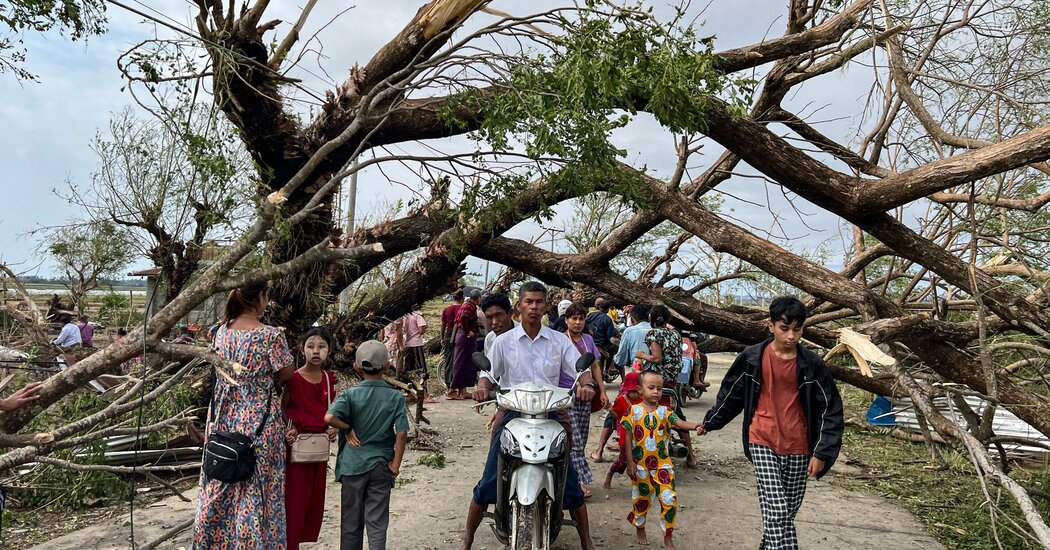Hundreds of thousands of people began repairing or rebuilding their homes and livelihoods on Monday after a deadly cyclone hit Myanmar and Bangladesh over the weekend.
The storm, dubbed Mocha, killed several people in Myanmar, though there were conflicting reports from leaders about exactly how much. Myanmar’s government said there were five, but the shadow government called the National Unity Government, which may have more resources in the country’s remote conflict areas, said it was 18.
Although damage from the powerful storm was not as extensive as predicted, hundreds of thousands of Rohingya refugees were still homeless, along with reports of stranded people having to fight their way through the storm’s debris to get home.
According to officials and aid workers, damage in Myanmar was largely confined to the states of Rakhine, Chin and other areas in the west.
Ko Myo Khaing, a rescue worker in the town of Sittwe, the capital of Rakhine state, said two people were killed in his area.
“At least 90 percent of Sittwe has been destroyed by the storm,” he said. “The electricity is still out and the telephone lines are down. The number of those affected is unknown due to communication problems.”
Khaing Thu Kha, a spokesman for the Arakan army, an ethnic Rakhine militia, said the food collected for the emergency had been damaged by the rains, and that while floodwaters had receded in Sittwe, it was still rising in other areas. was always high.
“Since it is impossible for us to help with our revolutionary forces alone, I would like to ask neighboring countries, including the UN, to help,” the spokesman said.
In Chin state, where phone and internet lines have been cut since Myanmar’s generals staged a coup in February 2021, communications were briefly restored just before the cyclone hit. But that wasn’t enough.
“We didn’t have enough time to tell people to evacuate,” said Salai Mang Hre Lian, the program manager of the Chin Human Rights Organization.
While there were no immediate reports of fatalities in Chin state, Mr Lian said more than a thousand people were stranded in the forests, in dire need of shelter, food and medicine, and unable to return to their homes. houses. The transportation was harrowing; travelers had to brave military patrols and unexploded ordnance, along with the effects of the storm itself. Those conditions also made it difficult to deliver relief supplies.
Before the cyclone made landfall, strong winds and rain tore through the tarpaulin and bamboo huts of the Rohingya refugees living in shabby camps along the Bangladesh coastline. More than a million Rohingyas took refuge in Bangladesh after fleeing persecution in Rakhine State, and they now live in the world’s largest encampment.
The storm made landfall on Sunday afternoon in the coastal area around Cox’s Bazar, right on Bangladesh’s border with Myanmar, according to the Bangladesh Meteorological Department. In that time, the Joint Typhoon Warning Center estimated winds of up to 250 kilometers per hour just before landing.
Videos posted to social media showed men and women wading in the water surrounded by broken power poles, blown-out tile roofs, pieces of billboards and crumpled metal plates.
In Bangladesh, where no immediate deaths were reported, about 3,000 Rohingya shelters were damaged by the cyclone, with some completely destroyed, officials said. The Office of the Commissioner for Refugees of Bangladesh reported that 32 learning centers and 29 mosques were damaged.
Stretching over rolling, muddy terrain, the refugee camps suffered 120 landslides during the storm and at least 5,300 refugees were moved to safer locations. A total of 13,000 homes were damaged or destroyed in the wider Cox’s Bazar region. According to the government of Bangladesh, about 250,000 people were in need of food and shelter on Sunday night.
In the Cox’s Bazar area, 25-year-old Arefa, who goes by one name and lives with her husband and two children, ages 6 and 4, described in horror how the storm knocked down a tree on top of her bamboo and plastic hut . The family escaped unharmed and fled to the home of a community leader.
“I lay down on the floor of someone’s house with my kids next to me and thought, ‘Are we going to be doing this for the rest of our lives?'” she said, her voice trembling.
A series of fires and floods have ravaged Rohingya camps over the past six years, but Ms Arefa’s hut had been damaged only once before: two years ago, when another storm blew away the tarpaulin. Her family’s life in Myanmar had been tough even before October 2016, when armed troops came to her village and set it on fire. Her family was left homeless and had no choice but to flee to Bangladesh, she said, a journey that took several days on foot.
Now they have to start over. She came back to her battered cabin this morning, she said, to find that someone had stolen the cooking gas cylinder. “We want to go home to Myanmar, but there is no hope that will happen soon,” she said. “My two children, I don’t see a future for them.”
Judson Jones reporting contributed.

